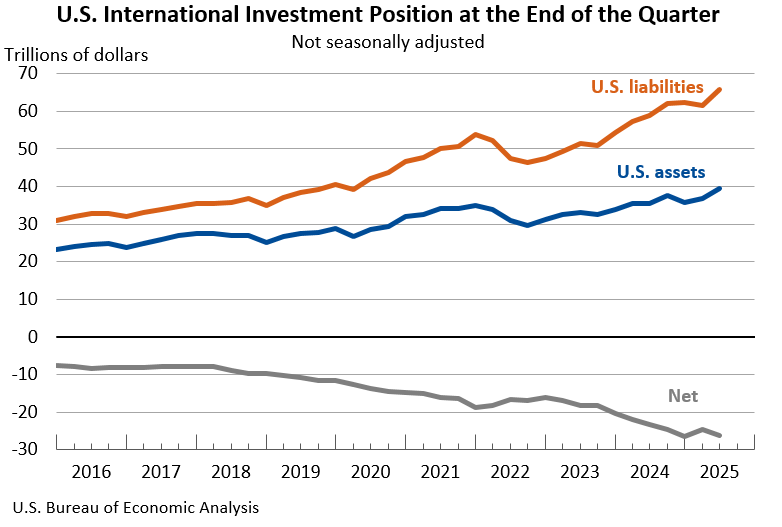Notice
Due to a lapse in appropriations, this website is not being updated.
Bureau of Economic Analysis
U.S. International Investment Position, 2nd Quarter 2025
The U.S. net international investment position, the difference between U.S. residents’ foreign financial assets and liabilities, was -$26.14 trillion at the end of the second quarter of 2025, according to statistics released today by the U.S. Bureau of Economic Analysis. Assets totaled $39.56 trillion, and liabilities were $65.71 trillion. At the end of the first quarter, the net investment position was -$24.65 trillion (revised).
Principal Federal Economic Indicators
Noteworthy
The Latest
U.S. International Trade in Goods and Services, Annual Revision
The U.S. monthly international trade deficit decreased in April 2019 according to the U.S. Bureau of Economic Analysis and the U.S. Census Bureau. The deficit decreased from $51.9 billion in March (revised) to $50.8 billion in April, as imports decreased more than exports. The previously published March deficit was $50.0 billion. The goods deficit decreased $1.0 billion in April to $71.7 billion. The services surplus increased $0.1 billion in…
Personal Income Rises In April
Personal income increased 0.5 percent in April after increasing 0.1 percent in March. Wages and salaries, the largest component of personal income, increased 0.3 percent in April after increasing 0.4 percent in March.
Personal Income and Outlays, April 2019
Personal income increased 0.5 percent in April after increasing 0.1 percent in March. Wages and salaries, the largest component of personal income, increased 0.3 percent in April after increasing 0.4 percent in March.
GDP Increases in First Quarter
Real gross domestic product increased 3.1 percent in the first quarter of 2019, according to the “second” estimate released by the Bureau of Economic Analysis. The growth rate was 0.1 percentage point lower than the “advance” estimate released in April. In the fourth quarter of 2018, real GDP rose 2.2 percent.
Gross Domestic Product, 1st quarter 2019 (second estimate); Corporate Profits, 1st quarter 2019 (preliminary estimate)
Real gross domestic product (GDP) increased at an annual rate of 3.1 percent in the first quarter of 2019, according to the "second" estimate released by the Bureau of Economic Analysis. In the fourth quarter, real GDP increased 2.2 percent.
Check Out the Buying Power in Your Metro Area
Interested in comparing buying power in your metropolitan area to another? Then, you’ll want to look at the Bureau of Economic Analysis’ latest batch of regional price indexes.
Some highlights from BEA’s recent news release, featuring our 2017 Regional Price Parities:
Real Personal Income for Metropolitan Areas, 2017
The percent change in real metropolitan area personal income ranged from 14.8 percent in Midland, MI to -5.9 percent in Enid, OK.
Real Personal Income for States, 2017
The percent change in real state personal income ranged from 4.5 percent in New York to -1.3 percent in North Dakota.
Real Personal Income for States and Metropolitan Areas, 2017
Real state personal income grew 2.6 percent in 2017, after increasing 1.5 percent in 2016, according to estimates released today by the Bureau of Economic Analysis. Real state personal income is a state's current-dollar personal income adjusted by the state's regional price parity and the national personal consumption expenditures price index. The percent change in real state personal income ranged from 4.5 percent in New York to -1.3…
March 2019 Trade Gap is $50.0 Billion
The U.S. monthly international trade deficit increased in March 2019 according to the U.S. Bureau of Economic Analysis and the U.S. Census Bureau. The deficit increased from $49.3 billion in February (revised) to $50.0 billion in March, as imports increased more than exports. The previously published February deficit was $49.4 billion. The goods deficit increased $0.5 billion in March to $72.4 billion. The services…




